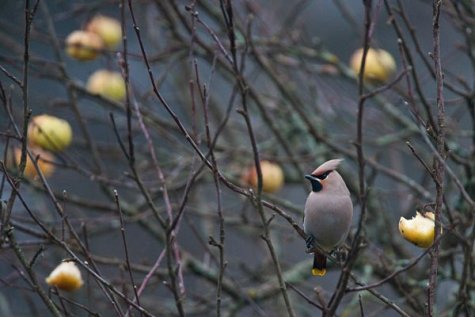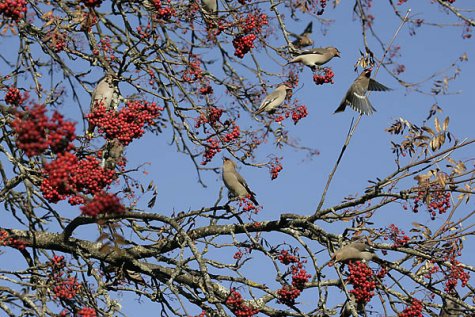Table laid for waxwings
Photos Arne Ader
Sound of nature Veljo Runnel
Translation Liis
Waxwings in apple tree
Listen to the twitter: LINK
Waxwing; Bohemian waxwing Siidisaba or viristaja Bombycilla garrulus
The northern nesters reach us when weather in the summer homeland is growing cold and food gets scarce. There is enough to do for our waxwings this year, rowans are red, hawthorns full of berries, apple trees still have fruits. In Finland the weather turned wintery, now they reach us by and by; in poor rowan years the waxwings only stay briefly here, in the hope of finding edibles in the south they sometimes migrate to the Mediterranean or Caucasus. They move during daytime; generally the flocks stay smaller than 100 individuals, but sporadically in some few years flocks reaching up to thousands of birds are not rare.
The flight view of waxwings with their triangular wings is similar to that of starlings as is the size. In flight view waxwings look dark but let us look closer at the exterior of the beautiful birds: the main colours of the silkily gleaming plumage are silky grey underparts and reddish brown. A black ”robber mask” around the eyes, a patch of the same colour on the throat. Adults as well as young birds have a proud crest. The beak is strong, the tip slightly crooked. Wing feathers black, for ”garnish” yellow, white and red. The tips of the primaries yellow. More can be said about colours but we will leave this to an interested reader’s own discovery.
About differences between young and adult birds: this summer’s young ones still lack the black patch at the throat, wings are less colourful and the silky sheen duller. The legs of adults are black, those of young birds reddish. Studied by binoculars the difference is clearly visible.
Waxwing observations: LINK
Waxwings in rowan tree










